Distinguished Critique: "Batman: A Death in the Family" Review
This classic tragedy is constructed upon some coincidence yet serves as a much-needed arc for a spurned Robin who develops before he dies
—by Nathan on May 9, 2023—
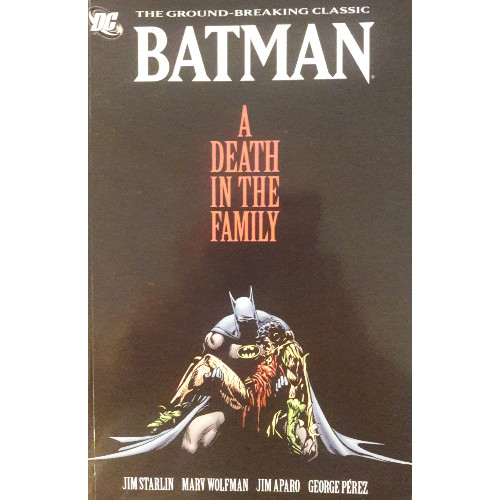
Several Batman issues after Frank Miller’s "Year One" redefined his origin, our favorite Caped Crusader caught a young orphan trying to steal wheels off his Batmobile. Seeing something spunky in the cheeky lad, Batman took in Jason Todd and turned him into the second boy wonder to adopt the mantle of Robin.
Jason, however, soon proved he was not the same kid Dick Grayson, the first Robin, had been. Spunk turned to impetuousness as Bruce’s new ward took greater and greater risks, culminating in the deaths of a couple of criminals (one which Jason was only "maybe" responsible for–wink-wink, nudge-nudge). Point being, he certainly wasn’t Dick Grayson...and fans didn’t like him.
So what to do with a Robin who doesn’t sing to the tune of the assembled Batman fandom? As history shows, DC chose to clip his little wings.
And they had a little help with that fandom I just mentioned.
"A Death in the Family"
Writer: Jim Starlin
Penciler: Jim Aparo
Inker: Mike DeCarlo
Colorist: Adrienne Roy
Letterer: John Constanza
Issues: Batman #426-429
Publication Dates: December 1988-January 1989
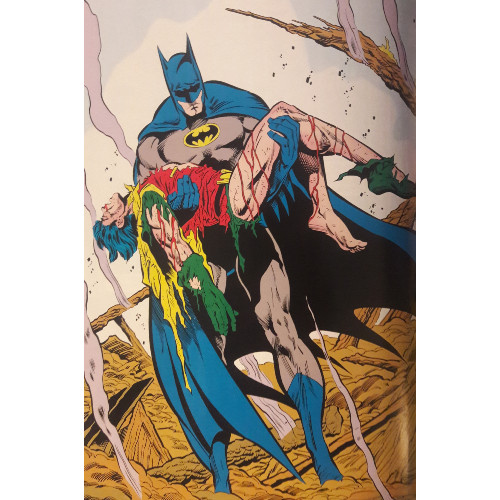
Note: save for some minor edits, this blog is the same as it was when I originally posted it to Hubpages
This story, as the name implies, doesn’t end happily. If you’re reading this, you either know Jason’s fate or have had over thirty years to figure it out, but let’s be momentarily blunt: Jason doesn’t make it out alive.
He’d come back, naturally. Everybody does. That whole “The only people who stay dead in comics are Uncle Ben, Bucky, and Jason Todd” statement doesn’t hold nearly as much water as it used to. Heck, we should expect dear old Ben to have secretly run away to Havana all those years ago, but I digress…
This story, by our two Jims, is important for two reasons: the death of Jason Todd...and how DC decided to kill him.

Jim Starlin, no stranger to powerful character deaths, strings together a story that doesn’t even necessarily tease Jason’s untimely demise. For a story called “A Death in the Family,” Starlin doesn’t hype up the idea that Jason will soon be on the chopping block. Oh, sure, he inserts decent emotion into the plot, but his story about Jason seeking his long-lost mother seems more character defining than destructive. After nearly two years of this so-so Robin, “Death in the Family” seems to actually want to inject life into this flightless bird, letting the boy sprout wings of his own.
Pre-Crisis on Infinite Earths, Jason Todd was actually fairly similar to the first Robin–an acrobat orphaned when his parents are murdered (though, in a ghoulish twist, they’re killed by Killer Croc), Jason is taken in by Bruce and made the second Robin. Post-Crisis toyed with his origin, removing some of the Dick Grayson parallels and turning him into a little snot-nosed brat who lifted hubcaps. Jason’s recklessness may not have endeared him to fans, but as Starlin rightfully points out in the text, it’s a flaw he’s supposed to work on. This is, perhaps, the most interesting aspect of the tale. Starlin weaves a mystery, in a sense, toying with your emotions throughout. Will Jason overcome or succumb to his wanton anger and recklessness? Can Bruce get through to the boy? Will Jason find his mother? The arc feels character-driven, and whether or not you read it for the first time knowing its grisly final chapter (though good luck to anyone going into this thing completely blind), you learn to nevertheless appreciate Jason, even if just a little.
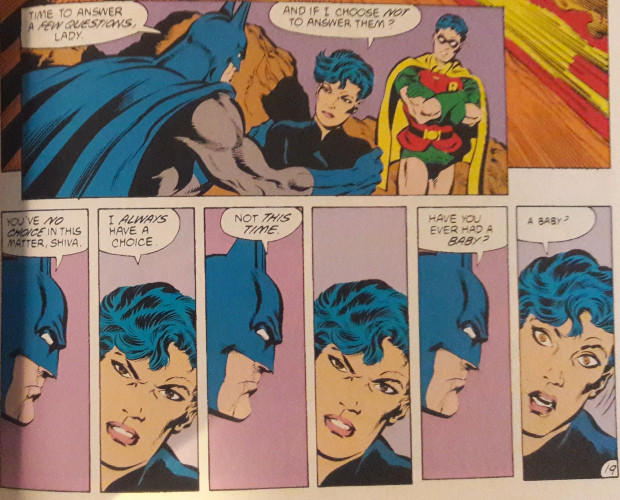
Maybe he’s unlikable, but isn’t that the point? We’ve got a character who’s so very unlike his predecessor (a flaw Batman wishes to correct), who operates under the guise of Robin much differently, and who Batman must have taken a more critical stance with. The “Batman/Robin” dynamic, even in these scant issues, is shifted from how it played out between Batman and Dick Grayson. At this point, Dick had distanced himself from Batman, setting aside the Robin moniker for his Nightwing identity and leadership role in the Teen Titans; even that team’s name identified his shift from boy to young adult. He was no longer the kid sidekick Batman needed. Batman, in bringing Jason in, seeks to fill the void created by Dick’s departure. And even though Nightwing’s substitute’s sore spirit made for a sticking point with fans, Jason’s aggressive attitude alters the dynamic of the dynamic duo.
I’m not saying fans were blind to this. Clearly, readers were not hugely in favor of Dick Grayson's replacement, given his ultimate fate. Perhaps tensions between Jason and Bruce were crafted too early in their working relationship, prior to a point where fans may have gotten used to the boy’s personality. The guy was only around for two years, mind. Starlin doesn’t harp on Jason’s strengths, necessarily, nor does he defend Jason’s arrogance and aggression. But he clearly sees it as a source of tension between the two characters and does what he can to enrich the narrative using Jason’s more solemn stance. I never felt like he was stringing the audience along, reminding them of why they dislike Jason. Or, at least, I never felt like Starlin wasn’t continuing the “unlikable Robin” angle just to stir up fans so they could kill him later. One might argue the arc’s “Death in the Family” title gives the entire plot away, but as uncovered art indicates, there were plans to save the lad in case the “For Jason” fanbase had won out.
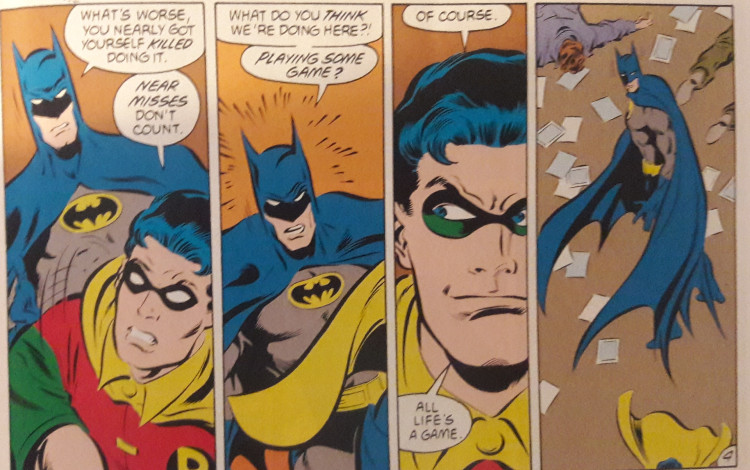
Which brings me to my second point, as indicated above. The nature of Jason’s death.
In Batman #427, Batman’s arch-enemy, that grinning Joker, catches the Boy Wonder unawares, beats him half to death with a crowbar, and then finishes the job by blowing up a warehouse, catching both Jason and his mother in the explosion. The issue ends with a call for fans to ring up DC and vote on Jason's fate. As history indicates, fans called one of two numbers (each for $.50)–the first if they wanted to save the Boy Wonder, the second if they wanted to condemn his young soul to the afterlife. For all the vitriol Jason caused, the margin was slim–out of over 10,000 calls, the decision came down to a mere 72 votes separating the “Jason Lives” crowd from the “Jason Dies” clique. Still, the thumbs titled down.
Similar to how Marv Wolfman wove in DC editorial’s multiversal streamlining plan into Crisis on Infinite Earths, Starlin impressively incorporates the fan-demanded demise into the story. Without teasing the dramatic death too much (or even teasing the idea that he’d place Jason in such a situation), Starlin works wonderfully through the moments leading up to Batman discovering Jason’s body. Suddenly, all that pathos Starlin injected into the previous chapters–Jason’s attitude, his attempts to find his mother, his disintegrating relationship with Batman–culminates, explosively and seemingly accidentally. There’s grief and dismay, with a hint of guilt, from the Dark Knight Detective. The boy he so desperately wanted to save from himself can never be saved now. You assume Starlin's emotional points could have worked the other had Jason lived, allowing Bruce to heal the rift in his relationship with Robin.
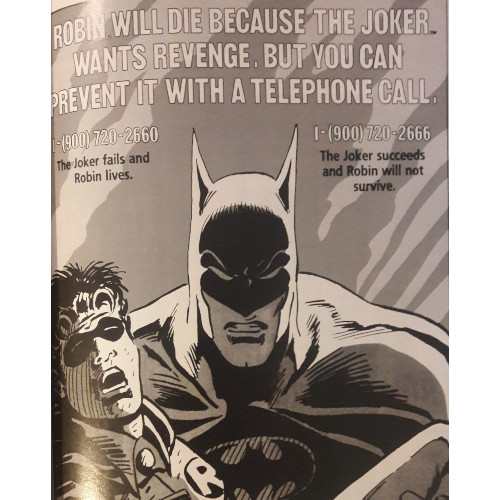
Where Starlin struggles in this story is incorporating the larger plot points that don’t deal directly with Jason and his doom. Even Jason’s search for his mother, though momentarily cathartic, is built upon coincidence. As important a villain as the Joker is to the entire story, his involvement with Jason is purely happenstance. Batman himself is forced to make a couple of hokey decisions, choosing to leave his young ward with a woman they just met and telling the lad not to take unnecessary risks, despite Jason’s predilection towards recklessness. Starlin clearly knows where he starts and where he wants to go; finding the proper narrative locomotion, unfortunately, tends to be a bit of an issue as the story evolves.
Starlin’s final chapter is also a bit bizarre, a strange note to end the tale on. Again, his intention is clear–Batman, desiring vengeance upon the Joker, is put in a position where he is unable to avenge Jason’s death. To do so, Starlin makes the Joker a Middle Eastern ambassador to the UN, and though Starlin interestingly weaves some Cold War era politics into the rest of the tale (including a cameo appearance by the Ayatollah Khomeini), this feels like a misstep. The whole final chapter–Joker as ambassador, Superman defending his position at the State Department’s behest, Batman’s incapacity–is just a tad far-fetched. Starlin bandies with certain ideas, such as Superman’s cooperation with the government impeding Batman’s wishes, that Frank Miller’s Dark Knight Returns toyed with, to superior effect. Here, shoved into the final issue, the concepts are batted about willy-nilly, all in favor of dragging out the long-standing Batman/Joker feud.
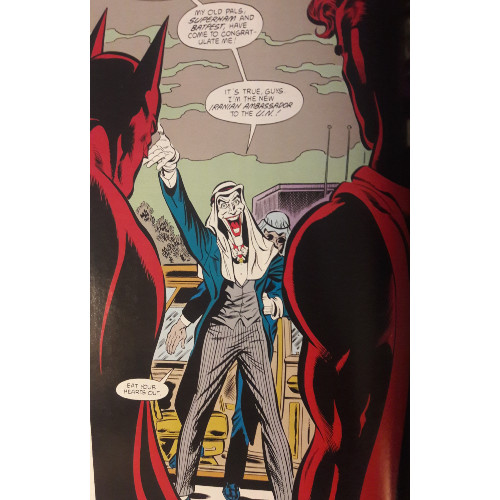
Poor Jason Todd. Beaten to death with a crowbar held by a maniacal clown yet condemned to die by the dimes of a populace. Much like Barabbus, the Joker was allowed to walk free as Pontius Starlin washed his hands clean of Jason’s blood. Jason’s life, of course, didn’t exactly end with his death, but Starlin made his temporary demise tragic. Yes, the story points surrounding and leading up to the moment of his death sometimes seem a little incidental, and the aftermath is a tad wonky, but Starlin has clear intentions and points he wants to make throughout the narrative. Jason needed an injection of empathy, so he got it. Jason’s fate was decided, so he died. The Joker needed to “get away,” as it were, so Starlin surrounded him with politics. And Batman, for a time, needed to brood, so he did. "A Death in the Family," though weak in some areas, remains largely strong, a classic in the minds of many and a reminder of how the readers themselves shape the worlds where our heroes dwell.